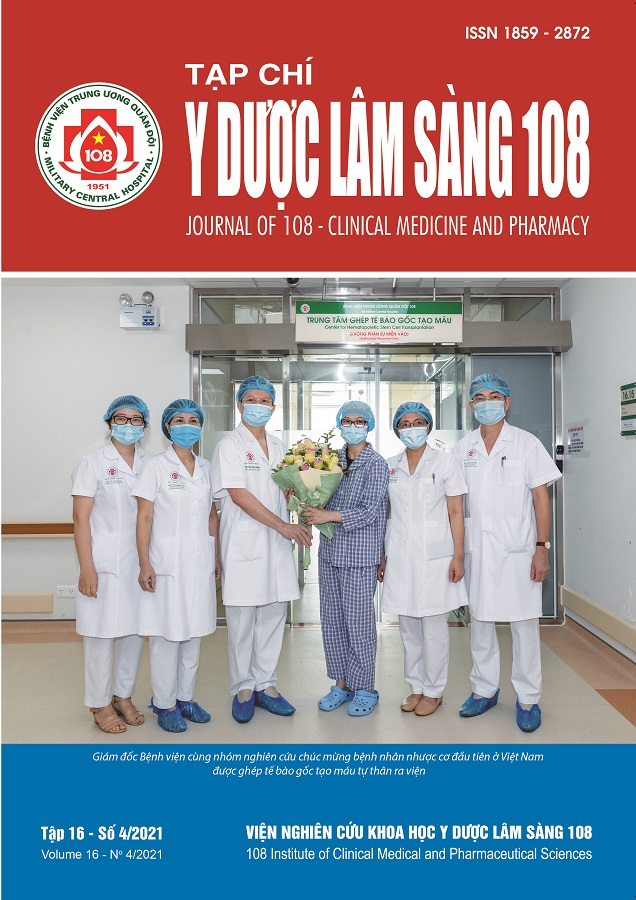Short-term outcomes of laparoscopic liver resection by the glissonean pedicle approach using Takasaki’s method for hepatocellular carcinoma
Main Article Content
Keywords
Abstract
Objective: To evaluate the short-term outcomes of Takasaki’s glissonean pedicles approach in laparoscopic liver resection for hepatocellular carcinoma. Subject and method: This was a prospective descriptive study of the cases who underwent laparoscopic liver resection using Takasaki’s glissonean pedicles approach for hepatocellular carcinoma in 108 Military Central Hospital from January 2019 to May 2021. Result: Elective surgery was performed for 54 patients. The average age was 56.2 ± 12 years, 90.7% of patients were male; hepatitis B related: 75.9%. The mean AFP was 193.6 ± 490ng/ml. The mean tumor size was 33.7 ± 16.3mm. Type of liver resection: Major hepatectomy (30.8%), small hepatectomy (69.2%). The conversion rate to open was: 3.7%. The median operation time was 194.5 ± 66.2 minutes, the median blood loss was 248.7 ± 171.6ml and the need for blood transfusion was required in 2 (3.8%) patients. The average length of hospital stay was 8.8 ± 3.8 days. Postoperative complications occurred in three patients (5.7%). The classification of complications according to Clavien were: I (33.3%), IIIb (33.3%), IVa (33.3%). There was no perioperative mortality. Conclusion: Laparoscopic liver resection using Takasaki’s glissonean pedicles approach for HCC is a feasible, safe, and effective method.
Article Details
References
2. Takasaki Ken (2007) Glissonean pedicle transection method for hepatic resection. Tokyo, Japan: Springer.
3. Yoon Yoo-Seok, Han HS, Choi YS et al (2006) Total laparoscopic right posterior sectionectomy for hepatocellular carcinoma. J Laparoendosc Adv Surg Tech A 16(3): 274-277.
4. Lương Công Chánh (2015) Nghiên cứu điều trị ung thư gan bằng phẫu thuật nội soi. Luận án tiến sĩ Y học - Viện NCKH Y Dược lâm sàng 108.
5. Trần Công Duy Long (2016) Đánh giá vai trò phẫu thuật nội soi cắt gan điều trị ung thư tế bào gan. Luận án tiến sĩ Y học - Đại học Y Dược thành phố Hồ Chí Minh.
6. Liu F, Wei Y, Chen K et al (2019) The extrahepatic glissonian versus hilar dissection approach for laparoscopic formal right and left hepatectomies in patients with hepatocellular carcinoma. J Gastrointest Surg 23(12): 2401-2410.
7. Cho CW, Rhu J, Kwon CHD et al (2017) Short-term outcomes of totally laparoscopic central hepatectomy and right anterior sectionectomy for centrally located tumors: A case-matched study with propensity score matching. World J Surg 41(11): 2838-2846.
8. Kim JH (2020) Laparoscopic anatomical segmentectomy using the transfissural Glissonean approach. Langenbecks Arch Surg 405(3): 365-372.
9. Machado MA, Surjan RC, Basseres T et al (2016) The laparoscopic Glissonian approach is safe and efficient when compared with standard laparoscopic liver resection: Results of an observational study over 7 years. Surgery 160(3): 643-651
10. Yue Hu, Shi J, Wang S et al (2021) Laennec's approach for laparoscopic anatomic hepatectomy based on laennec capsule. HPB 23: 179.
 ISSN: 1859 - 2872
ISSN: 1859 - 2872
